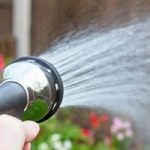Wise Watering
Water is a finite resource and should always be used wisely year round. Conservation is one means for consumers to do their part to preserve the resource for following generations. During the summer months one place to start is to substantially reduce water use in the garden.
For many of us, conserving water has not been a concern unless there is a prolonged drought. The growing population and thirst for water has been seriously taxing the world’s freshwater supply. Across North America water rates have been increasing up to 100% in some areas. You do not have to give up your flower or vegetable gardens in order to conserve water. There are a number of ways you can reduce water consumption without affecting your landscape beauty. Water Saving Tips: Soil improvement: The better your soil preparation, the greater your plant’s ability to survive. Plants in soils that are shallow or rocky will have poorer low-moisture endurance than those in deep loose soils where roots can penetrate deeply and easily. Add organic matter to the soil as you plant. Compost and other organic matter increase the soil’s ability to retain moisture. You can add organic matter every year to your beds, up to several inches a year that you work into the soil with a shovel or a roto-tiller. Mulch: Mulches conserve soil moisture by blocking evaporation. They also keep the soil cooler and help reduce weeds that will compete for moisture in the soil. Organic materials are generally considered the best mulches. Straw, pine needles, wood chips and other wood products are excellent for various effects in the landscape. These mulches also slow water runoff and enrich the soil as it breaks down. Compost makes good mulch and you can add an inch or two a year. Plants: Most perennials are an excellent choice for drought resistant landscapes. Their deeper roots have a better chance of obtaining moisture. Ornamental grasses are very popular and drought resistant. There are many websites that list drought resistant perennials, annuals, shrubs and trees. Just search under “drought resistant landscaping” and you will be sure to find listings for your area. Native plants are another fine choice. Improve potting mixes: When planters dry out, not enough moisture is available to the root system to carry the necessary nutrients to the plant for survival. As well, continual drying of the soil hardens the surface, making moisture penetration difficult. Consider adding water-retaining polymers to the soil. These water-absorbing crystals hold several hundred times their weight in water, which is released gradually to the plants’ roots. Watering: Infrequent deep watering is much more effective than frequent light watering. Plants are healthiest if you completely wet the root zone each time you water. Those people you see standing in the middle of their lawn watering with a hose are actually doing more harm than good. Water small plants, i.e. ground covers, lawns, annuals and vegetables to a depth of 1 foot. Non-established medium size plants like shrubs need to be watered to a depth of 2 feet and trees, 3 feet. To make sure you are watering to the proper depth, push a long screwdriver into the soil. It will slide easily in wet soil; so water plants and lawn until you can easily slide the probe to the recommended depth. Water the plants in the early morning to give the plant time to absorb the water and get ready to handle heat, cold, or just the energy it takes to produce chlorophyll, grow, and move nutrients around. Also the water will not evaporate as readily as it does in the heat of the afternoon. Watering in the evening can cause fungal diseases if leaves are wet. It is best to water the soil, not the plants. Use a watering can, watering wand, soaker hose or drip irrigation that saturates the soil while leaving leaves dry. Just by using these few water conservation techniques you will not only reduce your water bill and help the environment, your plants will be much healthier. By Joan Adam
